| 1 |
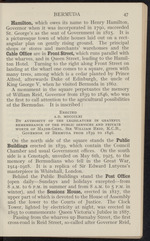 |
“...George’s as the seat of Government in 1815. It is
a picturesque town of white houses laid out on a rect-
angular plan on gently rising ground. The principal
shops or stores and merchants’ warehouses and the
Cable Office are in Front Street, which runs parallel with
the wharves, and in Queen Street, leading to the Hamil-
ton Hotel. Turning to the right along Front Street on
landing at the wharf one comes to a square, green with
many trees, among which is a cedar planted by Prince
Alfred, afterwards Duke of Edinburgh, the uncle of
King George V, when he visited Bermuda in 1862.
A monument in the square perpetuates the memory
of William Reid, Governor from 1839 to 1846, who was
the first to call attention to the agricultural possibilities
of the Bermudas. It is inscribed :
Erected
A.D. MDCCCLXI
By authority of the legislature in grateful
REMEMBRANCE OF THE PUBLIC SERVICES AND PRIVATE
worth of Major-Genl. Sir William Reid, K.C.B.,
Governor of Bermuda from 1839 to 1846.
On the north side of the square...”
|
|
| 2 |
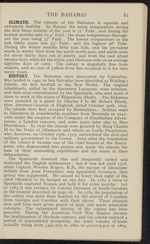 |
“...most of
them to work in the mines of Hispaniola (Haiti). The Bahamas
were included in a grant by Charles I to Sir Robert Heath,
then Attorney-General of England, dated October 30th, 1629.
The islands were first occupied by Bermudians. Settlers went
to Eleuthera in considerable numbers from Bermuda in 1647—
1660 under the auspices of the Company of Eleutherian Adven-
turers, a London concern, and some years later also to New
Providence. In 1670 the islands were granted by King Charles
II to the Duke of Albemarle and others as Lords Proprietors,
who, however, on October 27th, 1717, surrendered the civil and
military government to the Crown. Soon after the foundation
of the colony it became one of the chief haunts of the Bucca-
neers, who degenerated into pirates and made the islands the
base of their marauding expeditions and the scene of their
debaucheries.
The Spaniards resented this and frequently raided and
destroyed the English settlements ; but it was not until 1718,
when Captain Woodes...”
|
|
| 3 |
 |
“...personal effects which is made.
Rawson Square is separated by Bay Street from the
Public Buildings, forming three sides of a quadrangle,
in the centre of which is a statue of Queen Victoria,
unveiled by the late Sir William Grey Wilson, the then
Governor, on May 24th, 1905. The centre building
contains the Legislative Council Chamber, with the
General Post Office on the ground floor. In the former
are paintings of King George III, Queen Victoria, and
King Edward VII, and busts of Shakespeare, and the
Duke of Edinburgh, who as Prince Alfred, visited the
colony in 1862. That of the poet was ordered to com-
memorate the tercentenary of his birth, and was un-
veiled in 1867 by Lady Rawson, who also unveiled the
bust of King George V’s uncle in 1868. The eastern
wing contains various Government offices, while in the
western wing is the House of Assembly....”
|
|
| 4 |
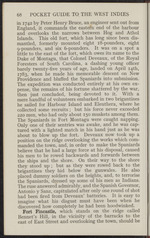 |
“...68 POCKET GUIDE TO. THE WEST INDIES
in 1742 by Peter Henry Bruce, an engineer sent out from
England, it commands the eastern end of the harbour
and overlooks the narrows between Hog and Athol
Islands. This old fort, which has long since been dis-
mantled, formerly mounted eight 18-pounders, eight
9-pounders, and six 6-pounders. It was on a spot a
little to the east of the fort, which owes its name to the
Duke of Montagu, that Colonel Deveaux, of the Royal
Foresters of South Carolina, a dashing young officer
barely twenty-five years of age, landed on April 14th,
1783, when he made his memorable descent on New
Providence and bluffed the Spaniards into submission.
The expedition was conducted entirely at his own ex-
pense, the remains of his fortune shattered by the war,
then just concluded, being devoted to it. With a
mere handful of volunteers embarked in two brigantines
he sailed for Harbour Island and Eleuthera, where he
collected some recruits; but his force never exceeded
220 men, who...”
|
|
| 5 |
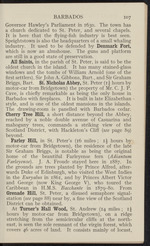 |
“...distance beyond the Abbey,
reached by a noble double avenue of Casuarina and
mahogany trees, commands a striking view of the
Scotland District, with Hackleton’s Cliff (see page 89)
beyond.
Farley Hill, in St. Peter’s (16 miles; if hours by
motor-car from Bridgetown), the residence of the late
Sir Graham Briggs, is notable as being the original
home of the beautiful Farleyense fern (Adiantum
Farleyense). J. A. Froude stayed here in 1887. In
the grounds are trees planted by Prince Alfred, after-
wards Duke of Edinburgh, who visited the West Indies
in the Euryalus in 1861, and by Princes Albert Victor
and George (now King George V), who toured the
Caribbean in H.M.S. Bacchante in 1879-80. From
Grenade Hill, St. Peter, a disused semaphore signal-
station (see page 88) near by, a fine view of the Scotland
District can be obtained.
At Turner’s Hall Wood, St. Andrew (14 miles; ij
hours by motor-car from Bridgetown), on a ridge
stretching from the semicircular cliffs at the north-
east, is seen the sole...”
|
|
| 6 |
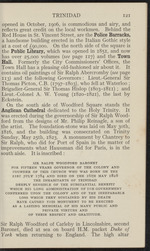 |
“...WAS BORN ON THE
2IST JULY 1784 AND DIED ON THE IÓTH MAY 1828
THE INHABITANTS OF TRINIDAD
DEEPLY SENSIBLE OF THE SUBSTANTIAL BENEFIT
WHICH HIS LONG ADMINISTRATION OF THE GOVERNMENT
CONFERRED UPON THE COLONY AND OF THE IRREPARABLE
LOSS WHICH THEY SUSTAINED BY HIS DEATH
HAVE CAUSED THIS MONUMENT TO BE ERECTED
AS A LASTING MEMORIAL OF HIS MANY PUBLIC AND
PRIVATE VIRTUES AND
OF THEIR RESPECT AND GRATITUDE.
Sir Ralph Woodford of Carleby in Lincolnshire, second
Baronet, died at sea on board H.M. packet Duke of
York when returning to England. The high altar...”
|
|
| 7 |
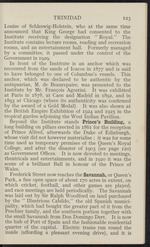 |
“...M. de Beaurepaire, was presented to the
Institute by Mr. Francis Agostini. It was exhibited
at Paris in 1878, at Caen and Madrid in 1892, and in
1893 at Chicago (where its authenticity was confirmed
by the award of a Gold Medal). It was also shown at
the British Empire Exhibition of 1924 and 1925 in the
tropical garden adjoining the West Indian Pavilion.
Beyond the Institute stands Prince’s Building, a
long building on pillars erected in 1861 for the reception
of Prince Alfred, afterwards the Duke of Edinburgh,
whose visit did not however materialise ; it was for some
time used as temporary premises of the Queen’s Royal
College, and after the disaster of 1903 (see page 120)
as Government Offices. It is now devoted to meetings,
theatricals and entertainments, and in 1920 it was the
scene of a brilliant Ball in honour of the Prince of
Wales.
Frederick Street now reaches the Savannah, or Queen’s
Park, a fine open space of about 170 acres in extent, on
which cricket, football, and other games...”
|
|
| 8 |
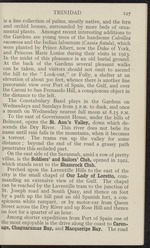 |
“...TRINIDAD
Ï27
is a fine collection of palms, mostly native, and the fern
and orchid houses, surrounded by more beds of orna-
mental plants. Amongst recent interesting additions to
the Gardens are young trees of the handsome Colvillea
racemosa and the Indian laburnum (Cassia fistula), which
were planted by Prince Albert, now the Duke of York,
and Princess Marie Louise during their visits in 1913.
In the midst of this pleasance is an old burial ground.
At the back of the Gardens several pleasant walks
can be taken, and visitors should not omit to ascend
the hill to the “ Look-out,” or Folly, a shelter at an
elevation of about 300 feet, whence there is another fine
panoramic view over Port of Spain, the Gulf, and over
the Caroni to San Fernando Hill, a conspicuous object in
the distance to the left.
The Constabulary Band plays in the Gardens on
Wednesdays and Sundays from 5 p.m. to dusk, and once
a month on Wednesday nearest full moon at 8.15 p.m.
To the east of Government House, under the...”
|
|
| 9 |
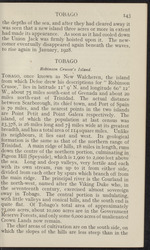 |
“...Its geological
formation is the same as that of the northern range of
Trinidad. A main ridge of hills, 18 miles in length, runs
down the centre of the northern portion, culminating in
Pigeon Hill (Speyside), which is 1,900 to 2,000 feet above
the sea. Long and deep valleys, very fertile and each
with its own stream, run up to it from either side,
divided from each other by spurs which branch off from
the main ridge. The principal river is the Courland in
the north-west, named after the Viking Duke who, in
the seventeenth century, exercised almost sovereign
sway in Tobago. The central portion is undulating,
with little valleys and conical hills, and the south end is
quite flat. Of Tobago’s total area of approximately
73.000 acres, about xo,ooo acres are in the Government
Reserve Forests, and only some 6,000 acres of unalienated
Crown Lands now remain.
The chief areas of cultivation are on the south side, on
which the slopes of the hills are less steep than in the...”
|
|
| 10 |
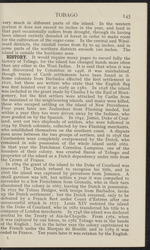 |
“...island of New Providence!
Four years later 200 Zealanders from Flushing landed, but
within a year they too were driven away by the Indians, who
were goaded on by the Spanish. In 1642, James, Duke of Cour-
land, sent out two shiploads of settlers, who were followed in
1654 by Dutch colonists, collected by two Flushing merchants,
who established themselves on the southern coast. A dispute
soon arose between the two groups of settlers, and in 1658 the
Courlanders were completely overpowered by the Dutch, who
remained in sole possession of the whole island until 1662.
In that year the Dutchman Cornelius Lampsius, one of the
founders of their colony, was created Baron of Tobago and
proprietor of the island as a Dutch dependency under title from
the Crown of France.
In 1664 the grant of the island to the Duke of Courland was
renewed. The Dutch refused to recognise his title, and in
1666 the island was captured by privateers from Jamaica. A
small garrison was left, but within a year it was compelled...”
|
|
| 11 |
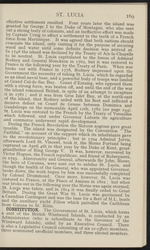 |
“...ST. LUCIA
169
effective settlement resulted. Four years later the island was
granted by George I to the Duke of Montague, who also sent
out a strong body of colonists, and an ineffective effort was
by Captain Unng to effect a settlement in the teeth of a French
force from Martinique. It was agreed that both nations should
toodUa^the 1f and' *°?ly siting it for the purpose of securing
wood and water until some definite decision was arrived at.
^48 the island was declared by the Treaty of Aix-la-ChapeUe
R eutLa! St- Lucia caPitulated to the forces of Admiral
^eaeraI Monckton in 1762, but it was restored to
rng year by the Treaty °f Paris. When war
broke out with France m 1778, Rodney impressed upon the
"ecesslty of taking St. Lucia, which he regarded
“ T baSCAand aP°werful body of troops was landed
Sith a .tnni'f6 “ ayv CoUnt d’Estaing, who opposed them
vnth a strong force was beaten off, and until the end of the war
rema*ned British, in spite of an attempt to recapture
of the ui*;h ^ from...”
|
|
| 12 |
 |
“...174 POCKET GUIDE TO THE WEST INDIES
spot, but also because of the magnificent view. In the
eighteenth century the Mome was the scene of much
fighting, and it was upon it that Prince Edward, Duke
of Kent, and great-grandfather of King George V, j
hoisted the English flag on April 4th, 1794, when the
island was captured from the French by Vice-Admiral
Sir John Jervis and Lieutenant-General Sir Charles Grey.
It was, too, from its works that the French republicans
were driven by Brigadier-General John Moore, after-
wards Sir John Moore, the hero of Corunna, two years
later.
The Mome now looks peaceful enough; but it presents
rather a melancholy appearance. Its officers’ quarters
are deserted and its barracks empty. The glorious view, .
however, remains and well repays the ride. It is more
extensive than that obtained from the terrace of Govern-
ment House, including as it does the superb mountain
ranges of the interior, a long stretch óf the coast-line
to the south, and the summits of the Pitons...”
|
|
| 13 |
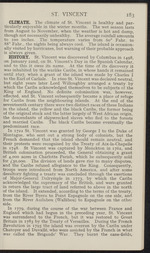 |
“... Vincent subsequently became a place of refuge
for Caribs from the neighbouring islands. At the end of the
seventeenth century there were two distinct races of these Indians
in the island, the yellow and the black Caribs, the former being
of the original stock and the latter largely of West African origin,
the descendants of shipwrecked slaves who fled to the forests
and married Caribs. The black Caribs became eventually the
predominant race.
In 1722 St. Vincent was granted by George I to the Duke of
Montague, who sent out a strong body of colonists, but the
French demanded that the island should remain neutral, and
their protests were recognised by the Treaty of Aix-la-Chapelle
in 1748. St Vincent was captured by Monckton in 1762, and
British colonisation proceeded, the General obtaining a grant
of 4,000 acres in Charlotte Parish, which he subsequently sold
for £30,000. The division of lands gave rise to many disputes,
and the Caribs refused allegiance to the King. Consequently,
troops...”
|
|
| 14 |
 |
“...between Ottley Hall Estate and the Ordnance Lands,
which is inscribed to the memory of our soldiers who
fell in the " Brigands’ War ” of 1795-96 (see page 183).
The inscription runs:
To
The Memory of
Many Brave
SOLDIERS
Particularly of the
46TH & 69TH Reg. and of the Island Militia and
Rangers who fell in defending this Colony in the
Years 1795 & 1796
This Pillar
is Erected on the Boundary of Ottley Hall Estate
and the Garrison of Fort Charlotte
by W. L. Uebuury (sic)
B.O.
The 46th is now the 2nd Duke of Cornwall’s Light
Infantry, and the 69th the 2nd Welch Regiment.
The fort was formerly the chief defence of the island.
It contained barracks for six hundred men, and had
thirty-four pieces of artillery and several outworks. In
1854 the garrison was withdrawn, though one company
of the 16th Bedfordshire Regiment returned in 1867 and
remained for six years. Some of the old military build-
ings are now used to house the colony’s paupers. The
fort is approached by a narrow archway which gives
access...”
|
|
| 15 |
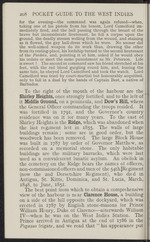 |
“...nt lunatic asylum. An obelisk in
the cemetery on the Ridge bears the names of officers,
non-commissioned officers and men of the 54th|Regiment
(now the 2nd Dorsetshire Regiment), who died in
Antigua, St. Kitts, Dominica, and St. Lucia, March,
1848, to June, 1851.
The best point trom which to obtain a comprehensive
view of the harbour is near Clarence House, a building I
on a side of the hill opposite the dockyard, which was I
erected in 1787 by English stone-masons for Prince I
William Henry, Duke of Clarence—alterwards William j
IV—when he was on the West Indies Station. The j
Prince arrived in Antigua at the end of 1786 in the |,
Pegasus frigate, and we read that “ his appearance put...”
|
|
| 16 |
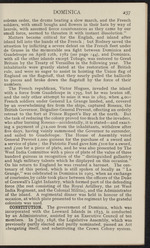 |
“...£200 for a piece of plate, and he was also presented by The
West India Committee with a piece of plate of the value of three
hundred guineas in recognition of the “ distinguished gallantry
and high military talents which he displayed on this occasion."
On his return to England he was created a baronet. The cen-
tenary of this period, which is still spoken of locally as " La
Grange,” was celebrated in Dominica in 1905, when an exchange
of courtesies.by cable took place between the officers of the Duke
of Cornwall’s Light Infantry, which formed part of the defending
force (the rest consisting of the Royal Artillery, the 1st West
India Regiment, and the Colonial Militia), and the Administrator
of the island. A regimental dinner was held in honour of the
occasion, at which plate presented to the regiment by the grateful
colonists was used.
CONSTITUTION. The government of Dominica, which was
incorporated with the Leeward Islands in 1833, is conducted
by an Administrator, assisted by an Executive...”
|
|
| 17 |
 |
“...l Bartholomew
Rowley (1811). In the churchyard are the tombs of
Janet Scott, sister of Michael Scott (author of “ Tom
Cringle’s Log ”), of Robert Bogle, his brother-in-law,
and of Robert Hamilton, who was the original " Aaron
Bang ” in the “ Log.”
Amongst other places of worship in Kingston are the
Roman Catholic Cathedral, a conspicuous building with
a dome, at the eastern end of North Street; St. George’s
in East Street, St. Michael’s in East Queen Street (both
Anglican); the Scotch Kirk in Duke Street, the Calabar
Church (Baptist) in East Queen Street; the Wesley
Chapel in Tower Street; and the Jewish Synagogue in
East Street.
Beyond the Parish Church facing down King Street
is a Statue of Queen Victoria from the chisel of E.
Edward Geflowski, which was erected in 1897 at a cost
of £800, voted by the Legislature to commemorate the
Diamond Jubilee. Though the statue was not over-
thrown by the earthquake ten years later, it was turned
about a third of the way round on its pedestal by...”
|
|
| 18 |
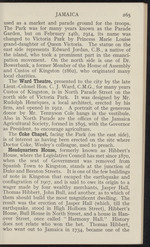 |
“...North Parade are the offices of the Jamaica
Agricultural Society, formed in 1895, with the Governor
as President, to encourage agriculture.
The Coke Chapel, facing the Park (on the east side),
is of interest as having been erected on the site where
Doctor Coke, Wesley’s colleague, used to preach.
Headquarters House, formerly known as Hibbert’s
House, where the Legislative Council has met since 1870,
when the seat of Government was removed from
Spanish Town to Kingston, stands at the junction of
Duke and Beeston Streets. It is one of the few buildings
of note in Kingston that escaped the earthquake and
conflagration of 1907, and is said to owe its origin to a
wager made by four wealthy merchants, Jasper Hall,
Thomas Hibbert, John Bull, and another, as to which of
them should build the most magnificent dwelling. The
result was the erection of Jasper Hall (which, till the
earthquake, stood in High Holbom Street), Hibbert’s
House, Bull House in North Street, and a house in Han-
over Street, once...”
|
|
| 19 |
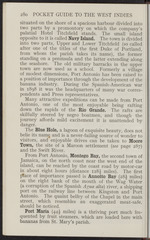 |
“...280 POCKET GUIDE TO THE WEST INDIES
situated on the shore of a spacious harbour divided into
two parts by a promontory on which the company’s
palatial Hotel Titchfield stands. The small island
opposite to it is called Navy Island. The town is divided
into two parts, Upper and Lower Titchfield (so called
after one of the titles of the first Duke of Portland,
from whom the parish takes its name), the former
standing on a peninsula and the latter extending along
the seashore. The old military barracks in the upper
town are now used as a school. Formerly a village
of modest dimensions, Port Antonio has been raised to
a position of importance through the development of the
banana industry. During the Spanish-American war
in 1898 it was the headquarters of many war corres-
pondents and Press representatives.
Many attractive expeditions can be made from Port
Antonio, one of the most enjoyable being rafting
down the rapids of the Rio Grande. The rafts are
skilfully steered by negro boatmen, and...”
|
|
| 20 |
 |
“...Bath a
visit can be made to the sugar-growing district of Vere.
At the south-eastern extremity of Vere is Portland
Cave, at the foot of Portland Ridge, a visit to which is,
however, only recommended to the adventurous. From
Vere a splendid road passing the Salt River and Cockpit
River leads to Old Harbour.
Williamsfield (53 miles, 2 hours and 20 minutes from
Kingston) is the station for Mandeville (2,061 feet),
a favourite resort of English visitors which owes its
name to the second title of the Duke of Manchester,
Governor in 1808. The village (5 miles from the station)...”
|
|
